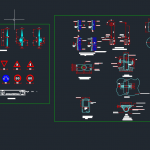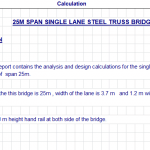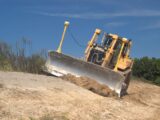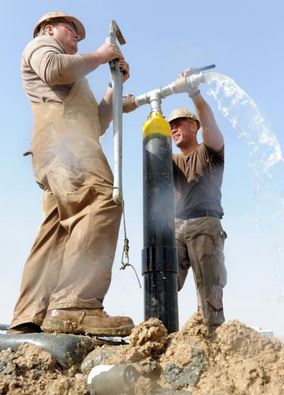
Drilling Wells Methods – Advantages and Disadvantages
5 June 2021Table of Contents
Drilling Wells Methods – Advantages and Disadvantages
There are several different types of drilling methods. Choosing a method depends on many factors including soil type, underground water level and common practice in every country. Cities using groundwater usually depend upon deep wells. These wells have the advantage of tapping deep and extensive aquifers. All deep wells are drilled wells. The successful digging of drilled wells requires special training, experience, tools and equipment.
The main methods of drilling wells are :
1- Rotary Drilling
The principle of rotary drilling is based upon a rotating drill stem made of lengths of drill pipe about 15 feet long. A bit is attached to a heavy stabilizer or drill collar at the end of the column of drill pipe. The extra weight and larger outside diameter of the stabilizer just above the bit helps to maintain a straight drill hole. The drill stem is hollow and has a drilling fluid of either mud or air circulating down the drill stem out through the nozzles in the bit and up along the outside of the drill stem. The rotating action of the bit breaks up the material and the drilling fluid carries the cuttings to the surface where they settle out in a mud tank.
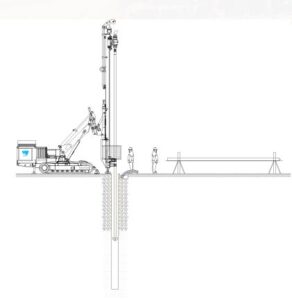
Advantages:
- Speed of Drilling: 5 to 7 times faster than cable tool, capable of several hundred feet per day (dependent on geologic material).
- Options of Well Design: Screen can be telescoped or attached, separate screens can be installed, filter packing to enhance formation production, down holle casing hammer method.
- Grouting: Oversized borehole requires grouting of annular space surrounding casing, most adaptable to various grout placement methods, practical for grout placement thru casing.
Disadvantages:
- Cost of Equipment: 5 times as costly as a cable tool or jetting rig, bit cost and tooling more
- Maintenance & Support: Much more extensive and costly than cable tool, higher fuel consumption, water truck needed.
2- Cable Tool Drilling
Cable tool drilling, also known as percussion drilling or spudding, is a widely used well drilling method.
Although it is a slower drilling method, the cable tool is less costly and simpler to operate than a rotary drill rig and is suitable for most geologic conditions.
The cable tool operates by raising and dropping a heavy drill string in the drillhole. The drill string, with bit on the bottom and rope socket (or swivel socket) on top, is suspended in the hole with a cable. The cable is threaded over the crown sheave located at the top of the mast, down to the walking beam, and onto the cable drum where it is stored.
The up-and-down drilling action imparted to the drill stem and cable by the walking beam. The walking beam is pivoted at one end, has a cable sheave at the other end and is connected to the crank gear with a pitman. Rotation of the crank gear causes the walking beam to move up and down. Additional cables called sand lines or casing lines are used to raise and lower casing, bailers, plungers, or other tools.
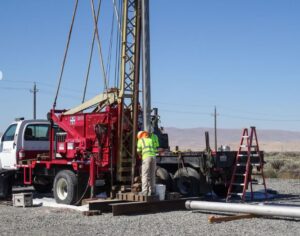
Advantages:
- Inexpensive Equipment: 1/5 cost of rotary rig, less grouting equipment needed, large water truck unnecessary, lower fuel consumption, lower operating cost.
- Limited Tooling Required: Bits can be resurfaced, less expensive tooling, used items readily available.
- Less Material Removed During Drilling: Generally, no oversized borehole, material removed from casing inside diameter, lighter soils can be bailed from casing.
- Repair Work: Cable tool rigs ideal for casing reaming, screen replacement, and
Disadvantages:
- Slow Drilling Speed: Bedrock drilling – 1/7 as fast as rotary drilling, Glacial drift drilling – 1/5 as fast as rotary drilling
- Depth Limitations with Single Casing String: Driving generally difficult in caving formations, ability to drive casing is limited by tool weight and ground
- Outer Casing Needed for Gravel Packing or Full Length Grouting: 3 to 4 inch larger casing needed to maintain annulus and must be extracated during grouting.
- Steel Casing Material Only: PVC casing can not be used unlesss installed in an oversized borehole without driving.
3- Auger Drilling
The auger method utilizes spiral augers, usually in 5 foot lengths. The auger stem is turned by a hydraulically-controlled rotary drive head. After drilling the length of an auger, the auger joint is broken and another 5 foot section is added.
Cuttings spiral their way up to the surface where they appear around the borehole, making formation identification relatively simple. If enough clay is present in the formation, the drillhole will remain open when augers are removed.
Dry sands and other caving formations may be a problem for the auger driller and will occasionally result in the loss of long flights of augers. When the auger encounters saturated sand (the water bearing formation to be screened), drilling generally can be continued for a short distance but the hole will not remain open in the saturated formation when the augers are removed.
The auger flight is then broken down and removed from the drillhole after drilling the depth of the well or when changing to another type of drilling operation.
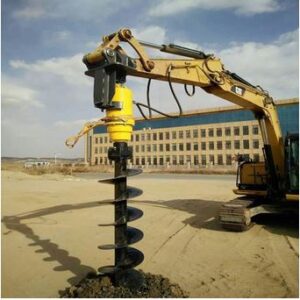
Advantages:
- Speed of Drilling: Fast for shallow holes without cobbles or gravel and with low water table, auger/cable tool or jetting combination rigs are common
- Limited Equipment: Less expensive than rotary, minimal amount of equipment
Disadvantages:
- Limited Depth: Poor results in caving formations, gravel, or high water table, less than 100 feet.
4- Hand Driving
Driven wells are common in many areas, especially around lakes where groundwater may be close to the surface.
Simple installation methods and the low cost of materials make them attractive to homeowners or cottage owners who wish to install their own water supplies.
However, since the well point and casing are driven into the ground, soil conditions are a major factor in suitability of the site. The site must be generally sandy and free of boulders or bedrock to be suitable for a driven well. Hard clay, silt, and very fine sand are generally difficult to drive through.
The installation of a driven well often begins by augering a hole with a hand auger or posthole digger as far as possible. A drive point, consisting of a reinforced well screen with a steel point on the end, is coupled to a 5 foot length of galvanized casing. The most common casing size for driven wells is 1-1/4 inch inside diameter.
A drive cap is placed an the top of the casing and a heavy weight is used to strike the top of the drive cap, driving the point into the ground, When the drive cap is driven close to the ground and driving cannot be continued, another length of casing is added and driving is resumed.
Special drive couplings are used to join sections of casing, Hand driving is usually accomplished by using a weighted driver consisting of a 3 or 4 foot piece of 3 inch diameter pipe capped on the top end. Extra weight is placed in the top portion of the driver. The driver fits over the casing and is guided by it. Another type of driver has a steel rod on the bottom that slides into the casing through a hole in the drive cap.
Raising and dropping the driver is done with the use of handles welded on the sides of the driver. The weighted driver may also be suspended from a tripod and tackle arrangement. The use of a sledge hammer for driving is not recommended since it may result in bent or broken casing from glancing blows.
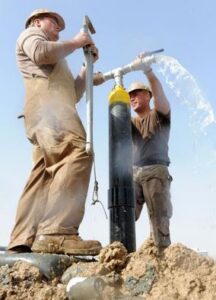
5- Jetting
Jetting is a drilling method suited for the sandy areas. Jetting remains a popular method for drilling small diameter wells due to its simplicity and inexpensive cost of equipment. Many of the portable, do-it-yourself drilling machines advertised in magazines utilize the jetting method.
Jetting and hollow-rod equipment are quite similar except that drilling water is pumped with the jetting method and the direction of water flow is opposite.
The jetting method involves using a high velocity stream of water to break up the formation material and wash the cuttings away. A chisel-shaped bit with holes to serve as nozzles is attached to the end of a string of hollow drill pipe. Water pressure is provided to the nozzles by using a high-pressure pump.
Water exits from the nozzles and loosens the material being drilled while keeping the bit clean. The bit is raised and lowered and rotated slightly to maintain a round hole. The cuttings are washed to the surface on the outside of the drill pipe and flow into a settling pit or tank.
Cutting samples are easily obtained at this point. A 55 gallon drum is often used for this purpose. After cuttings are allowed to settle, the water is recirculated through the pump, swivel, drill pipe and down to the bit. Jetting can also be done without recirculation of the drilling water; however, a continuous supply of water must be available at the site.
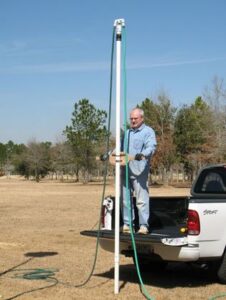
6- Hollow-Rod
Drilling Hollow-rod is referred to as the hydraulic-percussion drilling method.
The hollow-rod is an old drilling method that can be time consuming in some situations, but remains popular due to its simplicity and relatively low cost of equipment.
Most hollow-rod wells are 2 inch diameter, but 4 inch casings are installed occasionally. This method is well suited for sand and soft clay formations with relatively few boulders. It can also be used for drilling rock wells, but progress is slowed considerably. Wells several hundred feet in depth have been completed by the hollow-rod method.
The drill string used in hollow-rod drilling is similar to that used in jetting, except that the chisel bit has a ball check valve in it. Water or a clay-water mixture is kept in the annular space between the drill rods and well casing to help prevent the uncased portion of the hole from collapsing.
The water is supplied to the annulus by gravity intake from a small mud tank. A 55 gallon drum is often used as a settling tank. Drilling is done by lifting and dropping the drill stem and bit. The drill pipe used has triple wall thickness to add weight to the drill string.
The drill string is also rotated slightly by hand during each stroke to maintain a round drill hole. As the bit drops, the ball check opens and mud and cuttings enter the hollow drill rods. On the upstroke, the check valve closes and keeps the cuttings in the drill rods.
Advantages:
- Inexpensive Equipment: 1/5 cost of rotary rig, less grouting equipment needed, large water truck unnecessary, lower fuel consumption, lower operating cost.
- Limited Tooling Required: Bits can be resurfaced, less expensive tooling, used items readily available, many tools
- Less Material Removed During Drilling: Generally no oversized borehole, material removed from casing inside diameter.
- Repair Work: Jetting rigs ideal screen replacement and development.
Disadvantages:
- Slow Drilling Speed: Bedrock drilling – uncommon, requires heavy drill bar, 1/7 as fast as rotary drilling, Glacial drift drilling – 1/5 as fast as rotary drilling, limited use in gravel formations.
- Depth Limitations with Single Casing String: Driving generally difficult in caving formations, ability to drive casing is limited by tool weight and ground
- Outer Casing Needed for Gravel Packing or Full Length Grouting: 3 to 4 inch larger casing needed to maintain annulus and must be extracated during grouting.
- Steel Casing Material Only: PVC casing can not be used unlesss installed in an oversized borehole without driving.

